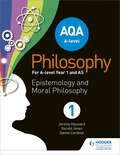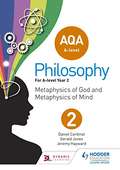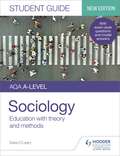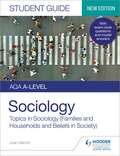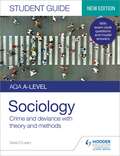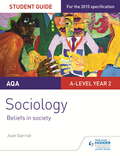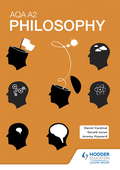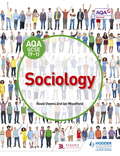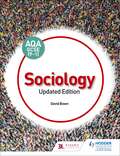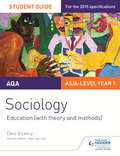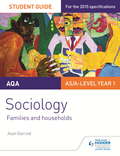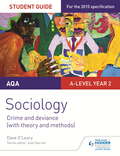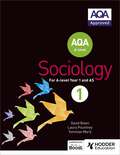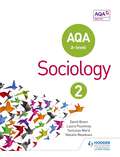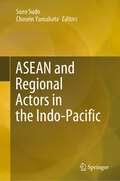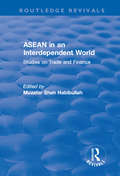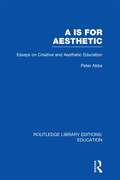- Table View
- List View
AQA A-level Philosophy Year 1 and AS: Epistemology and Moral Philosophy
by Dan Cardinal Jeremy Hayward Gerald JonesExam Board: AQALevel: AS/A-levelSubject: PhilosophyFirst Teaching: September 2016First Exam: June 2017Enable students to critically engage with the new 2017 AQA specifications with this accessible Student Book that covers the key concepts and philosophical arguments, offers stimulating activities, provides a key text anthology and assessment guidance.- Cements understanding of complex philosophical concepts and encourages students to view ideas from different approaches through clear and detailed coverage of key topics.- Strengthens students' analytical skills to develop their own philosophical interpretations using a variety of inventive and thought-provoking practical activities and tasks.- Encourages students to engage with the anthology texts, with references throughout and relevant extracts provided at the back of the book for ease of teaching and studying.- Stretches students' conceptual analysis with extension material.- Helps AS and A-level students to approach their exams with confidence with assessment guidance and support tailored to the AQA requirements.
AQA A-level Philosophy Year 1 and AS: Epistemology and Moral Philosophy
by Dan Cardinal Jeremy Hayward Gerald JonesExam Board: AQALevel: AS/A-levelSubject: PhilosophyFirst Teaching: September 2016First Exam: June 2017Enable students to critically engage with the new 2017 AQA specifications with this accessible Student Book that covers the key concepts and philosophical arguments, offers stimulating activities, provides a key text anthology and assessment guidance.- Cements understanding of complex philosophical concepts and encourages students to view ideas from different approaches through clear and detailed coverage of key topics.- Strengthens students' analytical skills to develop their own philosophical interpretations using a variety of inventive and thought-provoking practical activities and tasks.- Encourages students to engage with the anthology texts, with references throughout and relevant extracts provided at the back of the book for ease of teaching and studying.- Stretches students' conceptual analysis with extension material.- Helps AS and A-level students to approach their exams with confidence with assessment guidance and support tailored to the AQA requirements.
AQA A-level Philosophy Year 2: Metaphysics of God and metaphysics of mind
by Dan Cardinal Jeremy Hayward Gerald JonesEnable students to critically engage with the new 2017 AQA specifications with this accessible Student Book that covers the key concepts and philosophical arguments, offers stimulating activities, provides a key text anthology and assessment guidance.- Cements understanding of complex philosophical concepts and encourages students to view ideas from different approaches through clear and detailed coverage of key topics.- Strengthens students' analytical skills to develop their own philosophical interpretations using a variety of inventive and thought-provoking practical activities and tasks.- Encourages students to engage with the anthology texts, with references throughout and relevant extracts provided at the back of the book for ease of teaching and studying.- Stretches students' conceptual analysis with extension material.- Helps AS and A-level students to approach their exams with confidence with assessment guidance and support tailored to the AQA requirements.
AQA A-level Philosophy Year 2: Metaphysics of God and metaphysics of mind
by Dan Cardinal Jeremy Hayward Gerald JonesExam board: AQALevel: A-levelSubject: PhilosophyFirst teaching: September 2017First exams: Summer 2019Enable students to critically engage with the new 2017 AQA specifications with this accessible Student Book that covers the key concepts and philosophical arguments, offers stimulating activities, provides a key text anthology and assessment guidance.- Cements understanding of complex philosophical concepts and encourages students to view ideas from different approaches through clear and detailed coverage of key topics.- Strengthens students' analytical skills to develop their own philosophical interpretations using a variety of inventive and thought-provoking practical activities and tasks.- Encourages students to engage with the anthology texts, with references throughout and relevant extracts provided at the back of the book for ease of teaching and studying.- Stretches students' conceptual analysis with extension material.- Helps AS and A-level students to approach their exams with confidence with assessment guidance and support tailored to the AQA requirements.
AQA A-level Sociology Student Guide 1: Education with theory and methods
by Dave O'LearyReinforce understanding of the content examined in A-level Paper 1: Education with Theory and Methods, including Education, Methods in context, and Theory and methods.Packed full of clear topic summaries, knowledge check questions and sample exam-style questions and answers with commentaries, this guide will help students aim for and achieve the highest grades.This Student Guide will help to:- Identify key content for the exams with our concise coverage of topics- Avoid common pitfalls with clear definitions and exam tips throughout- Reinforce learning with bullet-list summaries at the end of each section- Test knowledge with rapid-fire knowledge check questions and answers- Find out what examiners are looking for with our Questions & Answers section
AQA A-level Sociology Student Guide 1: Education with theory and methods (Student Guides)
by Dave O'LearyReinforce understanding of the content examined in A-level Paper 1: Education with Theory and Methods, including Education, Methods in context, and Theory and methods.Packed full of clear topic summaries, knowledge check questions and sample exam-style questions and answers with commentaries, this guide will help students aim for and achieve the highest grades.This Student Guide will help to:- Identify key content for the exams with our concise coverage of topics- Avoid common pitfalls with clear definitions and exam tips throughout- Reinforce learning with bullet-list summaries at the end of each section- Test knowledge with rapid-fire knowledge check questions and answers- Find out what examiners are looking for with our Questions & Answers section
AQA A-level Sociology Student Guide 2: Topics in Sociology (Families and households and Beliefs in society)
by Laura Pountney Joan GarrodReinforce understanding of the two most popular options for A-level Paper 2: Topics in Sociology, including Families and Households, and Beliefs in Society.Packed full of clear topic summaries, knowledge check questions and sample exam-style questions and answers with commentaries, this guide will help students aim for and achieve the highest grades.This Student Guide will help to:- Identify key content for the exams with our concise coverage of topics- Avoid common pitfalls with clear definitions and exam tips throughout- Reinforce learning with bullet-list summaries at the end of each section- Test knowledge with rapid-fire knowledge check questions and answers- Find out what examiners are looking for with our Questions & Answers section
AQA A-level Sociology Student Guide 2: Topics in Sociology (Student Guides)
by Laura Pountney Joan GarrodReinforce understanding of the two most popular options for A-level Paper 2: Topics in Sociology, including Families and Households, and Beliefs in Society.Packed full of clear topic summaries, knowledge check questions and sample exam-style questions and answers with commentaries, this guide will help students aim for and achieve the highest grades.This Student Guide will help to:- Identify key content for the exams with our concise coverage of topics- Avoid common pitfalls with clear definitions and exam tips throughout- Reinforce learning with bullet-list summaries at the end of each section- Test knowledge with rapid-fire knowledge check questions and answers- Find out what examiners are looking for with our Questions & Answers section
AQA A-level Sociology Student Guide 3: Crime and deviance with theory and methods
by Dave O'LearyReinforce understanding of the content examined in A-level Paper 3: Crime and deviance with Theory and methods.Packed full of clear topic summaries, knowledge check questions and sample exam-style questions and answers with commentaries, this guide will help students aim for and achieve the highest grades.This Student Guide will help to:- Identify key content for the exams with our concise coverage of topics- Avoid common pitfalls with clear definitions and exam tips throughout- Reinforce learning with bullet-list summaries at the end of each section- Test knowledge with rapid-fire knowledge check questions and answers - Find out what examiners are looking for with our Questions & Answers section
AQA A-level Sociology Student Guide 3: Crime and deviance with theory and methods (Student Guides)
by Dave O'LearyReinforce understanding of the content examined in A-level Paper 3: Crime and deviance with Theory and methods.Packed full of clear topic summaries, knowledge check questions and sample exam-style questions and answers with commentaries, this guide will help students aim for and achieve the highest grades.This Student Guide will help to:- Identify key content for the exams with our concise coverage of topics- Avoid common pitfalls with clear definitions and exam tips throughout- Reinforce learning with bullet-list summaries at the end of each section- Test knowledge with rapid-fire knowledge check questions and answers - Find out what examiners are looking for with our Questions & Answers section
AQA A-level Sociology Student Guide 4: Beliefs in society
by Joan Garrod Tony LawsonWritten by experienced author Joan Garrod, this Student Guide for Sociology:- Identifies the key content you need to know with a concise summary of topics examined in the A-level specifications- Enables you to measure your understanding with exam tips and knowledge check questions, with answers at the end of the guide- Helps you to improve your exam technique with sample answers to exam-style questions- Develops your independent learning skills with content you can use for further study and research
AQA A2 Philosophy
by Dan Cardinal Jeremy Hayward Gerald JonesMotivate students to think philosophically with this accessible and imaginative guide for the latest specification, brought to you by the market-leading publisher for A-level Philosophy.Written by the authors of our bestselling AQA AS Philosophy textbook, this title covers both A2 units, Ethics and Philosophy of Mind, using the same clear style and modern examples throughout.- Cements knowledge and understanding of complex philosophical concepts through detailed coverage of key topics, student-friendly language and explanatory diagrams- Develops students' analytical skills and their own philosophical viewpoints using a variety of thought-provoking practical activities and tasks- Helps students to engage with the anthology texts at the back of the book with clear prompts in every chapter- Stretches high achievers through signposted extension material that enhances high-level critical thinking skills- Draws on the author team's extensive practical teaching experience to provide a coherent and stimulating route through the 2014 specification
AQA GCSE (9-1) Sociology
by Ian Woodfield Rosie OwensProgressively develop students subject knowledge, conceptual understanding and critical thinking skills with a wealth of targeted activities, guidance and assessment preparation tailored to the 2017 AQA GCSE Sociology specification.- Aid understanding of the main points and core concepts with key content summaries and accessible diagrams- Improve research skills with topical examples and methods in context sections for every topic- Extend learning and enhance responses with extension questions, stimulus material and suggestions for further reading - Prepare students for assessment with skills-building activities and practice questions developed for the new specification
AQA GCSE (9-1) Sociology, Updated Edition
by David BownFully revised and updated, AQA GCSE (9-1) Sociology will guide your students, topic-by-topic, through the 2017 specification, with features specially designed to be accessible to all students so they can:- ensure they have understood each topic and grasped key points with Content Summaries and Check your understanding questions- consolidate their knowledge with activities and extension opportunities to take them beyond the text- define and use key terms in the specification with confidence- use Research in Action sections to understand the work of key sociologists- prepare for assessments with Practice Questions based on the 2017 specification, together with answer guidance and commentaryAQA GCSE (9-1) Sociology has been reviewed by Sociology academics to ensure all content is accurate, sensitive, contextualised and evidence-based.
AQA GCSE (9-1) Sociology, Updated Edition
by David BownFully revised and updated, AQA GCSE (9-1) Sociology will guide your students, topic-by-topic, through the 2017 specification, with features specially designed to be accessible to all students so they can:- ensure they have understood each topic and grasped key points with Content Summaries and Check your understanding questions- consolidate their knowledge with activities and extension opportunities to take them beyond the text- define and use key terms in the specification with confidence- use Research in Action sections to understand the work of key sociologists- prepare for assessments with Practice Questions based on the 2017 specification, together with answer guidance and commentaryAQA GCSE (9-1) Sociology has been reviewed by Sociology academics to ensure all content is accurate, sensitive, contextualised and evidence-based.
AQA Sociology Student Guide 1: Education (with theory and methods)
by Dave O'LearyWritten by experienced teacher Dave O'Leary, this Student Guide for Sociology:- Identifies the key content you need to know with a concise summary of topics examined in the AS and A-level specifications- Enables you to measure your understanding with exam tips and knowledge check questions, with answers at the end of the guide- Helps you to improve your exam technique with sample answers to exam-style questions- Develops your independent learning skills with content you can use for further study and research
AQA Sociology Student Guide 2: Families and households
by Joan GarrodWritten by experienced author Joan Garrod, this Student Guide for Sociology:- Identifies the key content you need to know with a concise summary of topics examined in the AS and A-level specifications- Enables you to measure your understanding with exam tips and knowledge check questions, with answers at the end of the guide- Helps you to improve your exam technique with sample answers to exam-style questions- Develops your independent learning skills with content you can use for further study and research
AQA Sociology Student Guide 3: Crime and deviance (with theory and methods)
by Dave O'LearyWritten by experienced teacher Dave O'Leary, this Student Guide for Sociology:-Identifies the key content you need to know with a concise summary of topics examined in the A-level specifications-Enables you to measure your understanding with exam tips and knowledge check questions, with answers at the end of the guide-Helps you to improve your exam technique with sample answers to exam-style questions-Develops your independent learning skills with content you can use for further study and research
AQA Sociology for A-level Book 1
by David Bown Laura Pountney Tomislav MaricExam Board: AQALevel: AS/A-levelSubject: SociologyFirst Teaching: September 2015First Exam: June 2016Build students' understanding with this concept-driven approach to the 2015 AQA A-level Sociology specification, written by a team of leading subject authors and approved by AQA.- Develop the knowledge required to master Year 1 topics with clear and accessible content coverage- Build confidence in the evaluative skills needed to assess sociological theories and research- Strengthen learning and revision with a wealth of practice and extension questions and activities
AQA Sociology for A-level Book 1 (AQA A-Level #1)
by David Bown Laura Pountney Tomislav MaricExam Board: AQALevel: AS/A-levelSubject: SociologyFirst Teaching: September 2015First Exam: June 2016Build students' understanding with this concept-driven approach to the 2015 AQA A-level Sociology specification, written by a team of leading subject authors and approved by AQA.- Develop the knowledge required to master Year 1 topics with clear and accessible content coverage- Build confidence in the evaluative skills needed to assess sociological theories and research- Strengthen learning and revision with a wealth of practice and extension questions and activities
AQA Sociology for A-level Book 2
by David Bown Laura Pountney Tomislav Maric Natalie MeadowsExam Board: AQALevel: AS/A-levelSubject: SociologyFirst Teaching: September 2016First Exam: June 2017Build students' understanding with this concept-driven approach to the 2015 AQA A-level Sociology specification, written by a team of leading subject authors and approved by AQA.- Develop the knowledge required to master Year 2 topics with clear and accessible content coverage- Build confidence in the evaluative skills needed to assess sociological theories and research- Strengthen learning and revision with a wealth of practice and extension questions and activities
AQA Sociology for A-level Book 2
by David Bown Laura Pountney Tomislav Maric Natalie MeadowsExam Board: AQALevel: AS/A-levelSubject: SociologyFirst Teaching: September 2016First Exam: June 2017Build students' understanding with this concept-driven approach to the 2015 AQA A-level Sociology specification, written by a team of leading subject authors and approved by AQA.- Develop the knowledge required to master Year 2 topics with clear and accessible content coverage- Build confidence in the evaluative skills needed to assess sociological theories and research- Strengthen learning and revision with a wealth of practice and extension questions and activities
ASEAN and Regional Actors in the Indo-Pacific
by Sueo Sudo Chosein YamahataThis book discusses the shifting regional geopolitical engagements and development of rearranged connections emerging among ASEAN and non-ASEAN actors.First, the book focuses on the crucial discourse surrounding the Indo-Pacific region, including its challenges, continuity, and relevance. The discussion highlights the growing influence of regional actors such as India, Thailand, Japan, and the US, particularly in the context of a pressing question of collaboration versus containment amidst China’s rise. The book delves into various topics, such as geopolitical anxieties, economic strength, foreign policy, international relations, development, and security promotion in South and Southeast Asia, through the lenses of ASEAN centrality and the Indo-Pacific strategy.Second, the volume emphasizes on the escalating tensions and the worsening crises in the region that cause major anxieties and the subsequent realignment and new alignment of countries’ relationships. Among several chapters of the volume, a large Indo-China state, Myanmar, takes a special place in the book’s discussions as it has grown as an important ground for a resource/energy race among geopolitically strategic partners. Additionally, Myanmar has the potential to become a balancer in ASEAN. Therefore, any positive development and change in course of relations to Myanmar, particularly with its neighbors, Japan, and Russia, in both historical and contemporary contexts, can have a significant impact not only on Myanmar’s course towards peace, democracy, and security, but also regional stability. The editors and contributors examine the unique position of ASEAN, with a focus on ASEAN centrality as a platform for addressing anxieties and building relationships to bridge the gap between world and regional players, including both friends and foes.Overall, the volume provides valuable insights into the Indo-Pacific region’s complex dynamics, including cooperation and collaboration among regional actors for long-term stability and prosperity. The interdisciplinary composition of the book invites readers from various backgrounds to engage with constructive debates on general perception, contextual discussion, and the highlights of engaged research from local and international perspectives.
ASEAN in an Interdependent World: Studies in an Interdependent World (Routledge Revivals)
by Muzafar Shah HabibullahThis title was first published in 2000. This volume contains nine selected applied economic papers presented during the 1999 Faculty of Economics and Management Seminar in Melaka. The articles included focus the studies on trade and finance in Malaysia and other ASEAN member countries.
Aa is for Aesthetic: Essays on Creative and Aesthetic Education (Routledge Library Editions: Education)
by Peter AbbsThis volume reaffirms the indispensable place of the arts in any coherent curriculum. The author hopes that the specific arguments formulated in the book will advance the conservationist post-Modernist aesthetic.
